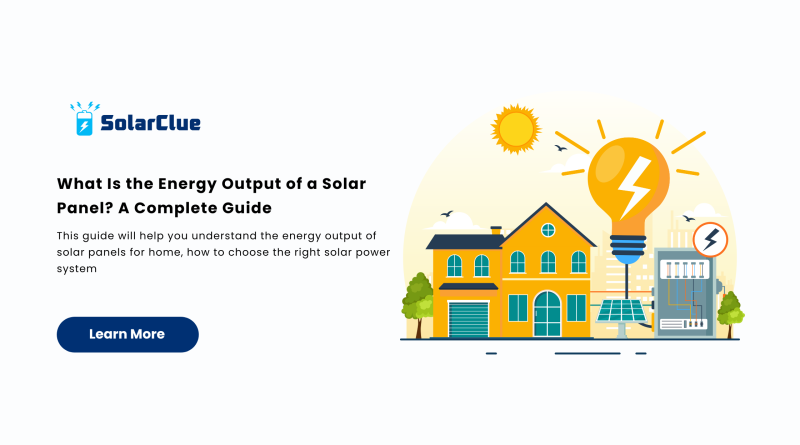What Is the Energy Output of a Solar Panel? A Complete Guide
With the rising demand for renewable energy, solar panels have become a popular choice for homeowners and businesses alike. But one common question remains: how much electricity does a solar panel produce? The answer depends on several factors, including the solar panel type, location, weather conditions, and installation angle.
This guide will help you understand the energy output of solar panels for home, how to choose the right solar power system, and the factors influencing electricity production. By the end, you’ll know how to estimate how much power you need and how to calculate your savings from solar energy.
Table of Contents
- 1 What Is Solar Panel and How Does It Work?
- 2 How Much Electricity Does a Solar Panel Produce Per Day?
- 3 1kW Solar Panel Produces How Many Units Per Day?
- 4 Factors Affecting Solar Panel Energy Output
- 5 How to Calculate the Right Solar Power System for Home?
- 6 Real-World Examples of Solar Panel Output
- 7 Future Trends in Solar Energy
- 8 FAQs
- 9 Final Thoughts
What Is Solar Panel and How Does It Work?
What Is Solar Panel?
A solar panel is a device that captures sunlight and converts it into electricity using photovoltaic (PV) cells. These cells absorb solar energy and generate Direct Current (DC) electricity, which is then converted into Alternating Current (AC) electricity through an inverter, making it usable for homes and businesses.
How Solar Panels Work?
1. Sunlight Exposure: Solar panels absorb sunlight and excite electrons in the PV cells.
2. Electricity Generation: The movement of electrons generates DC electricity.
3. Power Conversion: An inverter converts DC into AC electricity for home use.
4. Usage or Storage: The electricity is used immediately, stored in solar batteries, or sent back to the grid.
How Much Electricity Does a Solar Panel Produce Per Day?
The amount of electricity a solar panel produces depends on factors such as panel wattage, location, efficiency, and weather conditions.
1. A 300W solar panel produces about 1.2 kWh per day in ideal conditions.
2. A 400W solar panel generates around 1.6 kWh per day.
3. An entire 1kW solar power system produces 4-5 units per day.
If you receive 5-6 hours of direct sunlight per day, your solar power system will generate more energy compared to regions with lower sunlight availability.
1kW Solar Panel Produces How Many Units Per Day?
A 1kW solar panel system typically consists of 3-4 panels (each 300-350W) and produces:
1. 4-5 units per day under ideal sunlight conditions.
2. 120-150 units per month.
3. 1,500-1,800 units per year.
This is sufficient for running basic home appliances like lights, fans, refrigerators, and TVs. However, for higher power consumption, a 3kW or 5kW system may be required.
Factors Affecting Solar Panel Energy Output
1. Location & Sunlight Exposure – More direct sunlight results in higher energy production.
2. Solar Panel Efficiency – High-efficiency panels (above 20%) generate more power.
3. Panel Orientation & Angle – South-facing panels with optimal tilt angles capture the most sunlight.
4. Weather Conditions – Cloudy or rainy days reduce efficiency but still allow some energy generation.
5. Shading & Obstructions – Trees, buildings, or dirt on panels can lower output.
How to Calculate the Right Solar Power System for Home?
1. Check Your Electricity Bill – Find your average monthly energy usage (in kWh).
2. Determine System Size – Divide your monthly consumption by 30 to find your daily usage. Then, divide that by the daily output of a 1kW solar panel system.
3. Estimate the Number of Solar Panels – A 300W solar panel produces about 1.2 kWh per day. To determine the number of panels required, divide your daily energy need by the per-panel production.
Example Calculation:
1. If your home consumes 600 units per month, that’s 20 units per day.
2. A 1kW system produces 4-5 units per day, so you’d need about 4-5 kW of solar panels.
3. This equals 12-16 panels (assuming 300-350W per panel).
Real-World Examples of Solar Panel Output
Case Study: A Household in California
A homeowner in Los Angeles, CA installed a 5kW solar system, which generates 21-25 units per day. Over a year, this system produces 7,500-9,000 units, covering nearly 80% of their electricity needs.
Case Study: A Business in Texas
A 10kW solar power system installed at a small business in Austin, TX produces 40-50 units per day, reducing the company’s electricity costs by 60% annually.
Future Trends in Solar Energy
1. Bifacial Solar Panels – Capture sunlight from both sides, increasing efficiency.
2. Solar Roof Tiles – Aesthetic and functional, seamlessly integrated into homes.
3. Advanced Battery Storage – Innovations in lithium-ion and solid-state batteries.
4. Smart Solar Inverters – Optimize energy conversion for higher efficiency.
FAQs
1. How much electricity does a 5kW solar panel system produce per day?
A 5kW solar power system generates 20-25 units per day depending on sunlight conditions.
2. Can solar panels work on cloudy days?
Yes, but efficiency is reduced. Solar panels still generate 10-25% of their normal output under cloudy conditions.
3. How many solar panels do I need for a 3kW system?
A 3kW system requires about 9-12 panels (each 300-350W).
4. How long do solar panels last?
Most solar panels last 25-30 years, with efficiency gradually decreasing over time.
5. Is it worth investing in solar power for home?
Yes! A solar power system significantly reduces electricity bills and offers long-term savings, making it a great investment.
Final Thoughts
Investing in solar panels for home is one of the smartest decisions for reducing energy costs and promoting sustainability. By understanding how much electricity does a solar panel produce, you can choose the right solar power system for your needs.
If you’re considering solar energy, check solar panel price, available incentives, and installation options to maximize savings. With the right setup, you can enjoy reliable, renewable power for decades!
Stay curious, find everything you need on our website!



